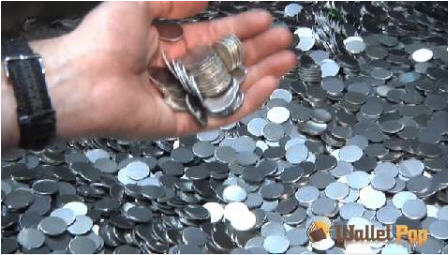
PREV ARTICLE
NEXT ARTICLE
FULL ISSUE
PREV FULL ISSUE
INTERVIEWS WITH U.S. MINT PERSONNEL
Blogger Jason Cochran published a great video interview with Joseph Menna and other designers at the U.S. Mint in Philadelphia. Check it out!
-Editor
I went to the United States mint in Philadelphia to meet some of the faces who create the money we all spend every day. I also found out how our national coin-making process has moved into the 21st century. As strange as it seems, a few years ago, one Mint employee's chance viewing of the Shrek DVD with his grandchildren ended up transforming the way our money is designed and delivered to us. On the day of my visit, the Mint was producing the new Yosemite quarter, the third in its new America the Beautiful series of 56 twenty-five cent pieces. Five designs will appear each year until 2021. Joseph Menna, one of the senior sculptor-engravers, is responsible for the back side of the Yosemite quarter, which will be released to the public on July 25.

All of the Mint's designers started out as gifted sculptors who are classically trained. Menna studied in Russia and is expert in handling bronze. In fact, as a mark of esteem, every engraver gets to add his or her initials to the money you use every day. Have a close look at the change in your pocket, and you'll find the signed handiwork of some of the only classically trained sculptors given a steady public forum in America today. But these masters don't work in clay much anymore; many of them now translate their skills to the virtual realm with specialized software called FreeForm, used by Hollywood and surgeons alike. Each software license costs as much as a down payment on a new house. Menna explains how the old art of coin-making has moved into modern times, yet has never abandoned the practical, classical training that has been demanded of sculptors for centuries. He also talks about the gratification that comes with being the creative mind behind what's jangling in your pocket right now.
To read the complete article, see:
Exclusive! The artists at the U.S. Mint who engrave our coins digitally now
(www.walletpop.com/blog/2010/06/28/exclusive-the-

There is also a nice video tour of the coin production floor. View it here:
Video exclusive! Watch the U.S. Mint make new Yosemite quarter
(www.walletpop.com/blog/2010/06/30/video-exclusive
There was also a great article on the new technology published in Numismatic News recently. It's available on NumisMaster.com. Here are a couple excerpts.
-Editor
Chief Engraver John Mercanti has seen and done it all. From the days of mixing plaster to create molds to sculpting with a computer, Mercanti has been a part of the design evolution, and a strong advocate of new technology. “In the old days, we would model the image and then I would actually make lines where the type was going to go, and I would go into a negative plaster and cut lettering by hand,” Mercanti said. “It could take longer to do the lettering than the artwork.” In fact, the accounting department once asked how long it took the engravers to make a letter. “We said 15 minutes,” Mercanti said. And remember, there are lots of letters on U.S. coins. “We used to hand punch the mintmark on every single die,” said Mercanti. “The Mint shop would bring 200 to 300 dies in and before we did any of the day's work, we had to take a punch and hammer and make the mintmark.” It was not a precise science. “We called them walking mintmarks because they'd be all over the place,” Mercanti said. Although there was a specific area the mintmark was meant to be placed, because it was done by hand, no two dies were identical. “The hardest denomination was the nickel, because (the mintmark) was out in space,” Mercanti said. But all that has changed with computer technology. “It would take up to three to five days to get one satisfactory die,” Mercanti said. “Now we have a good die on the first try 99 percent of the time.” But with new technology comes new challenges. On an easel in the corner of the third-floor conference room at the Philadelphia Mint, are the following words:
“What's causing cracking?”
The engravers had met earlier with the production staff to determine why cracking was occurring on some coins. It looked like technology got just a little too good. Janvier machines generated soft curves, Mercanti said. With computerized sculpting, distinctive lines can be made, and those hard edges may result in stress marks that cause cracking, he said. The answer? Go in and soften the lines created on the computer. “Sharp corners cause stress marks and under high stress, dies crack,” Mercanti said. “So what we have to do now is go back to the data and insert round corners and soften edges. “If we don't, we have die cracking, and that's unacceptable because we are judged on die life.”
To read the complete article, see:
Mint Engravers Embrace 21st Century Technology
(www.numismaster.com/ta/numis/Article.jsp?ad=article&ArticleId=11905)
The Numismatic Bibliomania Society is a non-profit organization promoting numismatic literature. See our web site at coinbooks.org. To submit items for publication in The E-Sylum, write to the Editor at this address: whomren@gmail.com To subscribe go to: https://my.binhost.com/lists/listinfo/esylum All Rights Reserved. NBS Home Page Contact the NBS webmaster 
|